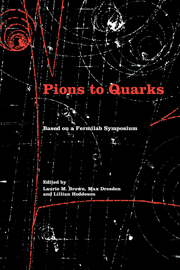Book contents
- Frontmatter
- Contents
- List of contributors
- Foreword by Leon M. Lederman
- Editors' acknowledgments
- Photographs of the symposium
- List of abbreviations
- List of notation
- I Introduction
- II Particle discoveries in cosmic rays
- III High-energy nuclear physics
- IV The new laboratory
- V The strange particles
- VI Weak interactions
- VII Weak interactions and parity nonconservation
- 29 The nondiscovery of parity nonconservation
- 30 K-meson decays and parity violation
- 31 The τ–θ puzzle: an experimentalist's perspective
- 32 The early experiments leading to the V–A interaction
- 33 Midcentury adventures in particles physics
- VIII The particle physics community
- IX Theories of hadrons
- X Personal overviews
- Name index
- Subject index
32 - The early experiments leading to the V–A interaction
Published online by Cambridge University Press: 07 May 2010
- Frontmatter
- Contents
- List of contributors
- Foreword by Leon M. Lederman
- Editors' acknowledgments
- Photographs of the symposium
- List of abbreviations
- List of notation
- I Introduction
- II Particle discoveries in cosmic rays
- III High-energy nuclear physics
- IV The new laboratory
- V The strange particles
- VI Weak interactions
- VII Weak interactions and parity nonconservation
- 29 The nondiscovery of parity nonconservation
- 30 K-meson decays and parity violation
- 31 The τ–θ puzzle: an experimentalist's perspective
- 32 The early experiments leading to the V–A interaction
- 33 Midcentury adventures in particles physics
- VIII The particle physics community
- IX Theories of hadrons
- X Personal overviews
- Name index
- Subject index
Summary
Never in my fondest dreams did I expect in January 1957 to be invited, twenty-eight years later, to reminisce about decisive experiments on symmetry violation in a great national laboratory directed by Leon M. Lederman. Such reminiscences not only are unnecessary (some of the key protagonists having already published their recollections in Maglich's nowdefunct journal) but also can be misleading. Nobody has total recall, and personal souvenirs can get warped by things heard but not experienced. Just recall Einstein's contradictory answers to the question whether he was or was not aware of the Michelson-Morley experiment in 1905.
Theoretical prologue
My friend Laurie Brown has asked me to include in my talk some remarks about the history of the theoretical developments in the field of weak interactions, as several of the main contributors to this field are present here but have chosen not to talk. I shall oblige Laurie Brown in some sense, but still avoid giving a chronological presentation devoid of personal reminiscences. Such presentations are available in standard textbooks.
Let me not praise famous men: It might be embarrassing (or insufficient) to them and to me. Let me instead mention a few early contributions that, for one reason or another, have rarely been cited in past reviews.
Before the famous Lee–Yang paper on parity nonconservation, theorists generally stated that there existed five different four-fermion couplings.
- Type
- Chapter
- Information
- Pions to QuarksParticle Physics in the 1950s, pp. 464 - 484Publisher: Cambridge University PressPrint publication year: 1989
- 1
- Cited by



